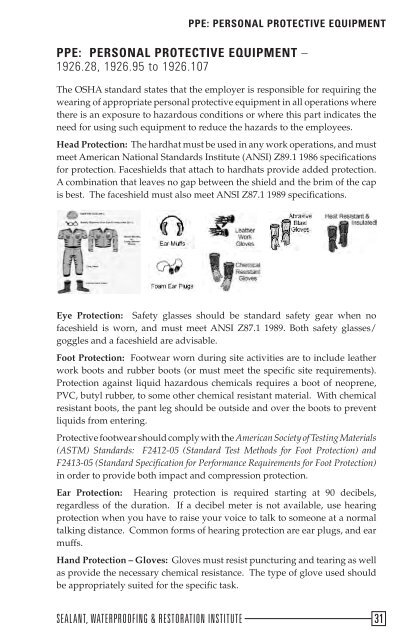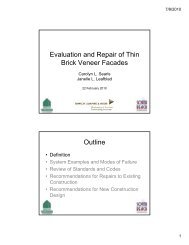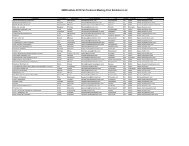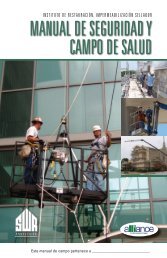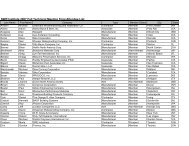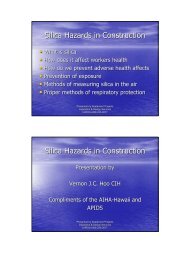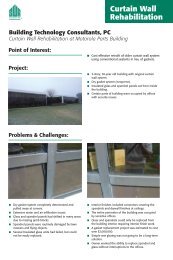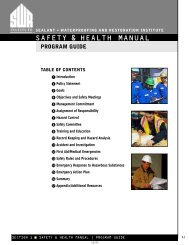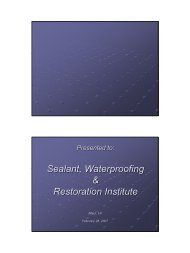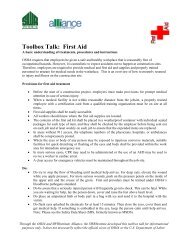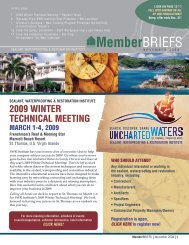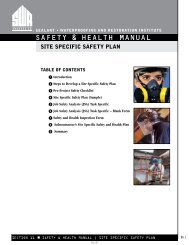Safety and Health Field Manual - the Sealant, Waterproofing and ...
Safety and Health Field Manual - the Sealant, Waterproofing and ...
Safety and Health Field Manual - the Sealant, Waterproofing and ...
You also want an ePaper? Increase the reach of your titles
YUMPU automatically turns print PDFs into web optimized ePapers that Google loves.
PPE: PERSONAL PROTECTIVE EQUIPMENT<br />
PPE: PERSONAL PROTECTIVE EQUIPMENT –<br />
1926.28, 1926.95 to 1926.107<br />
The OSHA st<strong>and</strong>ard states that <strong>the</strong> employer is responsible for requiring <strong>the</strong><br />
wearing of appropriate personal protective equipment in all operations where<br />
<strong>the</strong>re is an exposure to hazardous conditions or where this part indicates <strong>the</strong><br />
need for using such equipment to reduce <strong>the</strong> hazards to <strong>the</strong> employees.<br />
Head Protection: The hardhat must be used in any work operations, <strong>and</strong> must<br />
meet American National St<strong>and</strong>ards Institute (ANSI) Z89.1 1986 specifications<br />
for protection. Faceshields that attach to hardhats provide added protection.<br />
A combination that leaves no gap between <strong>the</strong> shield <strong>and</strong> <strong>the</strong> brim of <strong>the</strong> cap<br />
is best. The faceshield must also meet ANSI Z87.1 1989 specifications.<br />
Eye Protection: <strong>Safety</strong> glasses should be st<strong>and</strong>ard safety gear when no<br />
faceshield is worn, <strong>and</strong> must meet ANSI Z87.1 1989. Both safety glasses/<br />
goggles <strong>and</strong> a faceshield are advisable.<br />
Foot Protection: Footwear worn during site activities are to include lea<strong>the</strong>r<br />
work boots <strong>and</strong> rubber boots (or must meet <strong>the</strong> specific site requirements).<br />
Protection against liquid hazardous chemicals requires a boot of neoprene,<br />
PVC, butyl rubber, to some o<strong>the</strong>r chemical resistant material. With chemical<br />
resistant boots, <strong>the</strong> pant leg should be outside <strong>and</strong> over <strong>the</strong> boots to prevent<br />
liquids from entering.<br />
Protective footwear should comply with <strong>the</strong> American Society of Testing Materials<br />
(ASTM) St<strong>and</strong>ards: F2412-05 (St<strong>and</strong>ard Test Methods for Foot Protection) <strong>and</strong><br />
F2413-05 (St<strong>and</strong>ard Specification for Performance Requirements for Foot Protection)<br />
in order to provide both impact <strong>and</strong> compression protection.<br />
Ear Protection: Hearing protection is required starting at 90 decibels,<br />
regardless of <strong>the</strong> duration. If a decibel meter is not available, use hearing<br />
protection when you have to raise your voice to talk to someone at a normal<br />
talking distance. Common forms of hearing protection are ear plugs, <strong>and</strong> ear<br />
muffs.<br />
H<strong>and</strong> Protection – Gloves: Gloves must resist puncturing <strong>and</strong> tearing as well<br />
as provide <strong>the</strong> necessary chemical resistance. The type of glove used should<br />
be appropriately suited for <strong>the</strong> specific task.<br />
<strong>Sealant</strong>, waterproofing & Restoration Institute 31


